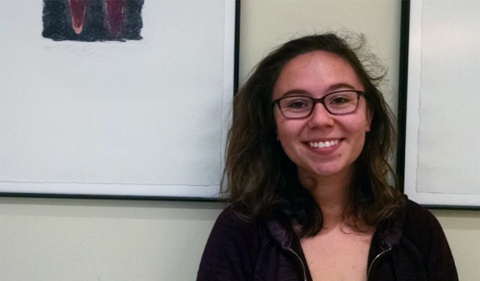By Juliana Scheiderer ’16
Mara Diaz ’18 knows what she wants to do and is on the road to achieve it. A sophomore with an interest in immigration issues, Diaz has taken advantage of everything Ohio University has to offer in order to prepare herself.
She is a Spanish major planning a trip abroad, and she is double majoring in Communication Studies, with a focus in Public Advocacy. She was recently accepted into the Law, Justice and Culture Certificate program in the College of Arts & Sciences.
According to Diaz, the Law, Justice & Culture program closely aligns with her goal of assisting newly arrived immigrants.
Helping People Newly Arrived to This Country
“I want to use Spanish to communicate with people newly arrived to this country, and I want to help with immigration issues. A lot of these issues have to do with the law,” Diaz explains.
Although her goals are clear, Diaz is still determining what path she will take to reach them. After graduation, she plans on applying to jobs, law school and public administration master’s programs.
Meanwhile, Diaz is involved in several prestigious organizations on campus. She currently holds a research apprenticeship and is a Margaret Boyd Scholar.
Diaz applied to her apprenticeship last semester, in an effort to find a job that also furthered her education. She was paired with Dr. Jerry Miller of the School of Communication Studies to assist him in researching how changing demographics of the United States affect political rhetoric. This position helped launch her own research project, a paper on how current presidential candidates choose to appeal to Hispanic voters.
“The biggest thing I’ve learned through this project is that when you’re conducting research, you don’t really choose a topic,” Diaz says. “You look at all the resources and allow themes to surface organically.”
As for the Margaret Boyd Scholars program, Diaz says that it is designed to connect young college women who are serious about education, networking and being a force of change on campus. This program admits female students in the first semester of their freshman year and follows them through their undergraduate career.
An Early Interest in Spanish
Diaz was drawn to Spanish from an early age. Her father is from Puerto Rico, and she attended a Spanish-language immersion program for elementary school. Her first trip to tour the school signaled an early love of the language.
“I just have this memory of hearing all this Spanish being spoken and my eyes being wide open, taking it all in,” Diaz recounts. “But the whole time my brother was covering his ears because he didn’t like hearing all these words he couldn’t understand. But I loved it.”
Diaz feels her Spanish skills are valuable in connecting her with her family, but also notes that Spanish is spoken in many parts of the world, and increasingly, in the United States.
“Almost 17 percent of U.S. citizens speak Spanish as a first language,” Diaz says. “It’s also a big part of the culture in the U.S., and learning the language helps you understand the culture.”
‘Language Is a Living Thing’
Along with understanding the culture, comes an understanding of people, specifically immigrants, Diaz says. She explains that learning another language can increase your compassion and understanding of the difficulties of fluency.
“I think when you study a language, you learn that language is a living thing, it’s constantly growing and constantly changing,” Diaz explains. “You can’t just learn it. You can’t just come to a country, live here for years, and then just drop your accent or just become fluent. I think it just gives you a really important perspective that language changes.”
Diaz explains that this applies to students learning Spanish, as well. She admits that at times it can be very difficult to progress past certain points to become fluent.
“I’ve felt stuck at a certain point of understanding before, where I understood a lot of Spanish, but wasn’t able to speak it fluently,” she says. “I’ve been stuck at this point of almost speaking Spanish.”
This is where the Modern Languages Department comes in, Diaz says. Through classes on culture and history, Diaz says she’s been able to fill in gaps in her understanding and improve her fluency.
“This program has been so beneficial with providing writing practice, so much more than I’ve ever had in any other Spanish experience,” she says. “It’s just been a really good way to fill in all gaps that I have in my Spanish.”
Using Spanish to Form Meaningful Connections
Diaz has applied this perspective to her own life, as well. Over the summer, she worked in a restaurant with a man who only spoke a little English. By using her Spanish language skills she was able to connect with him in a way she never expected.
“I have nothing in common with this guy at all, except I said, ‘Hablo un poco espanol,’” Diaz explains. “And his face just lit up at the fact that I’d be able to communicate with him a little bit more. After that, he’d hug me every time he saw me.”
It’s these connections that make Diaz’s language skills so valuable to her.
“You can connect to people you wouldn’t normally be able to connect with,” she says. “Being able to communicate with someone and help them out is so rewarding.”




















One Comment